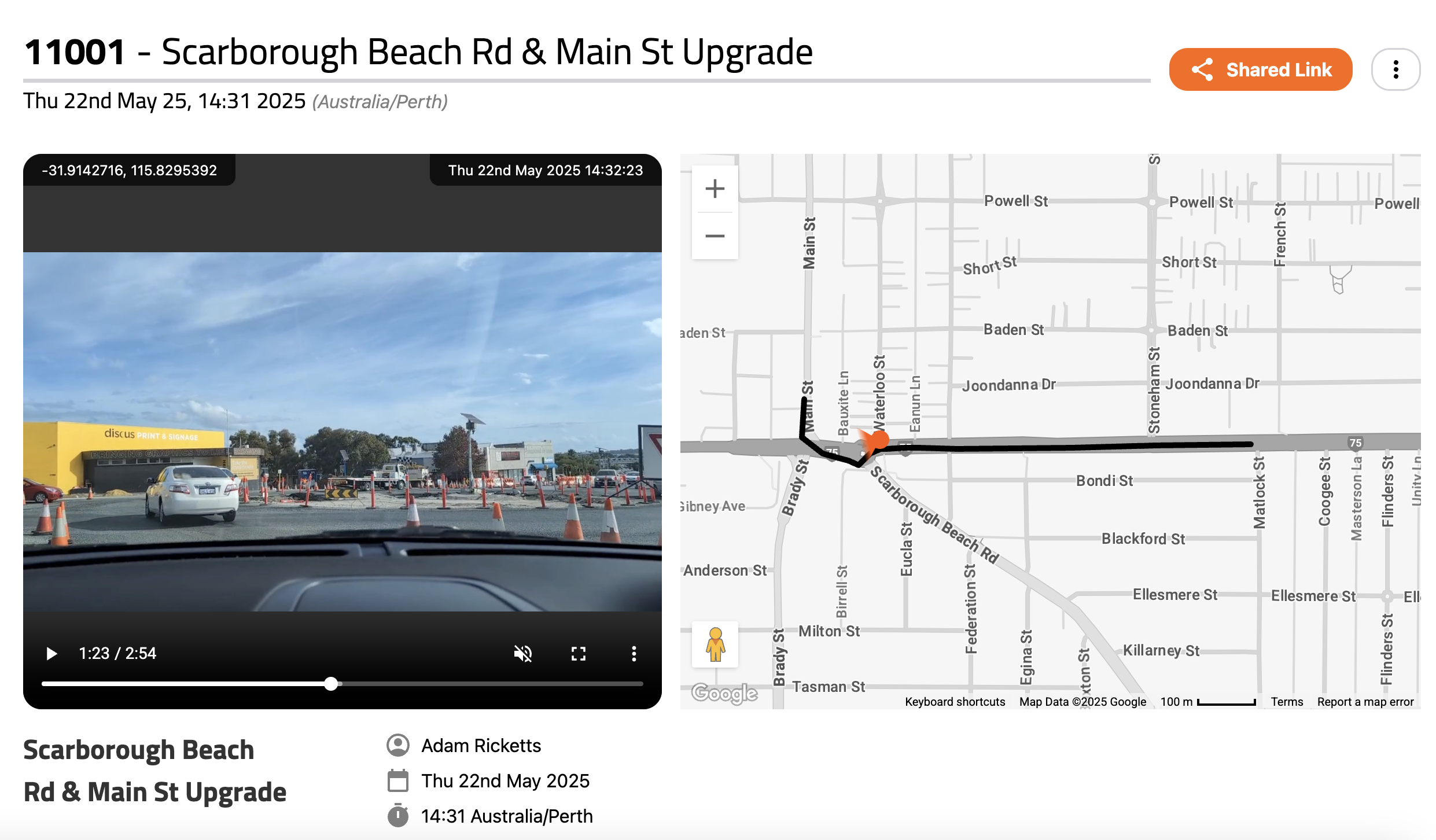The Role of Visual Proof in Reducing Legal Liability on Road Projects
In today’s high-risk construction and traffic management environment, legal disputes are not just possible — they’re likely. Whether it’s a public complaint, a workplace incident, a near miss, or a regulatory audit, your exposure to liability on road projects is ever-present. As regulatory standards tighten and public scrutiny increases, roadwork contractors, traffic management companies, and principal contractors need to do more than simply follow the rules.
They need proof they followed the rules.
That’s where visual evidence, especially in the form of timestamped, geo-tagged video recordings, plays a vital role. In this article, we’ll explore how visual proof can significantly reduce legal liability, and why it’s no longer a luxury — it’s fast becoming a necessity.
1. Understanding the Legal Exposure in Road Projects
Every road project operates within a minefield of legal and regulatory requirements. From Traffic Guidance Schemes (TGS) and Traffic Management Plans (TMP), to site inductions, permits, signage, and safety briefings — every aspect must be executed correctly and verifiably.
The legal risks can emerge from:
Public injuries (e.g. a pedestrian slips in an unbarricaded area)
Worker safety breaches (e.g. incorrect signage placement, or missing PPE)
Vehicle accidents (e.g. improper detours or lack of clear direction)
Non-compliance with government or council-issued permits
Allegations made during site audits or regulatory inspections
The problem is, even if your team did everything right, if you can’t prove it, you’re vulnerable.
This has become more evident in recent years as litigation has increased across construction and civil infrastructure. Claims are often made weeks or months after a project or setup — and by then, memories fade, crews change, and physical evidence is long gone.
That’s why proactive visual documentation is not just a box-ticking compliance measure — it’s legal defence.
2. Why Traditional Compliance Is No Longer Enough
In the past, traffic management and civil contractors relied on paper checklists, static photos, or memory to defend themselves. But in the age of real-time evidence and high-resolution data, that’s no longer sufficient.
Let’s look at three key shortcomings:
Photos are easily manipulated or taken out of context.
A photo of a properly placed sign doesn’t show whether it remained upright or whether it was placed on time.Written records can be incomplete or vague.
Site diaries and checklists don’t always accurately reflect real-world execution.Human memory is fallible.
Even the most experienced supervisors can misremember details, especially under legal pressure.
This is why authorities are increasingly pushing for more robust documentation practices. In Western Australia, for example, as of 1 January 2025, the Main Roads WA (MRWA) Code of Practice has introduced mandatory retention of evidence demonstrating TMP/TGS compliance — with video drive-throughs now recognised as an acceptable method of proof [Main Roads WA, 2024].
3. Real-World Scenarios Where Visual Proof Matters
A. Worker Falls in an Unbarricaded Area
Imagine a complaint is made that a traffic controller fell into an open trench because proper barriers weren’t erected. Without any footage, you’re forced to rely on site diaries and recollections. But if you had a timestamped site walkthrough video from just before the incident — showing compliant barriers in place — that’s hard to argue with.
B. Accusation of Missing Signage
In Victoria, the Department of Transport and Planning (DTP) uses a Traffic Management Surveillance Framework that involves random and risk-based inspections. In one publicly reported case, a contractor was flagged for not having advanced warning signage in place during setup.
Had a video been taken showing the signage in place at the time of setup, the contractor could have challenged the non-compliance finding [Victoria DTP, 2023].
C. Traffic Incident and Insurance Claim
A roadwork zone is blamed for a motor vehicle collision. A driver alleges that detour signs were confusing or not visible. If your team has cloud-stored video evidence from the exact day and time, showing signage was correctly placed, that could directly contradict the claim — potentially saving your business from liability or insurance payout.
These aren’t hypotheticals. They’re variations of real claims faced by contractors every year.
4. What Does “Legally Useful” Visual Evidence Look Like?
Not all video is created equal. To be useful in a legal context, visual proof should have the following attributes:
Date & Time Stamped
This removes any doubt about when the footage was taken.Geo-Tagged (Location Verified)
Confirms the footage was taken at the correct site location.Uneditable / Immutable Files
Protects against claims of evidence tampering.Stored Securely for the Duration of Risk
Some regulators require storage for 7 years; insurance investigations can take 12–24 months to close.Associated Metadata
Linking video to a specific project, supervisor, or work order enhances its defensibility.
Modern digital tools like mobile apps are making this type of recording simple, quick, and highly defensible.
5. The Growing Expectation from Clients and Regulators
It’s not just contractors and traffic controllers who benefit from video. Government clients and road authorities are increasingly expecting or requiring it.
In Queensland, for example, the Manual of Uniform Traffic Control Devices (MUTCD) has evolved to place responsibility not just on design and planning, but on the execution and verifiable implementation of temporary traffic control [Queensland TMR, 2023].
Similarly, SafeWork NSW has been enforcing construction safety through targeted inspections and fines, issuing over $55,000 in penalties in 2023 alone for traffic management-related breaches [SafeWork NSW, 2023].
These trends point to a shift from "trust us" to "show us."
And in legal proceedings, being able to show is everything.
6. How Video Changes the Risk Equation
Let’s break down exactly how video reduces risk:
When video becomes standard practice, the entire posture of your business shifts — from defensive to proactive.
7. Building a Culture of Documentation
Introducing visual documentation isn’t just about the tools. It’s about building a culture of accountability and consistency.
A few key steps to get there:
Train crews to record setups and walk-throughs regularly.
It should become part of their daily routine.Use centralised systems for storage and retrieval.
Videos need to be easy to find when you need them.Ensure supervisors know the legal importance.
The footage isn’t just for compliance — it’s their protection too.Review recordings as part of QA or HSE processes.
Visual documentation isn’t just reactive — it can be used to coach, improve and de-risk future projects.Keep retention aligned with legal requirements.
Ensure your solution or process retains files for at least 7 years if required.
8. Subtle Tools, Major Protection
Solutions like SiteStory offer exactly this kind of functionality: timestamped, location-verified video documentation of traffic management and construction site setups. But this article isn’t about software — it’s about the mindset.
Whether you're using a phone, a GoPro, or a specialist solution, the real goal is simple:
Protect your business with the truth - captured, stored, and ready to prove.
Legal protection is no longer about having the best argument. It’s about having undeniable evidence that your team did the right thing and can show it.
Conclusion
Visual proof has evolved from a nice-to-have into a core layer of legal defence for contractors and traffic management professionals. With audits, incidents, and claims becoming more common and compliance requirements tightening, the smartest teams are adapting now.
They aren’t just managing traffic.
They’re managing risk - with a camera in hand.
References
Main Roads Western Australia. Traffic Management for Works on Roads: Code of Practice (2024).
Section 4.8 “Evidence of Implementation.” Retrieved from www.mainroads.wa.gov.auVictoria Department of Transport and Planning (DTP). Traffic Management Surveillance Framework Overview (2023).
Retrieved from www.vicroads.vic.gov.auSafeWork NSW. Enforcement Statistics and Case Summaries: 2023 Report
Retrieved from www.safework.nsw.gov.auQueensland Department of Transport and Main Roads. Manual of Uniform Traffic Control Devices (MUTCD), Part 3 – Works on Roads (2023 Edition).
Retrieved from www.tmr.qld.gov.auAustralian Government, Fair Work Commission. Record-Keeping and the Fair Work Act (2022).
Retrieved from www.fwc.gov.au




